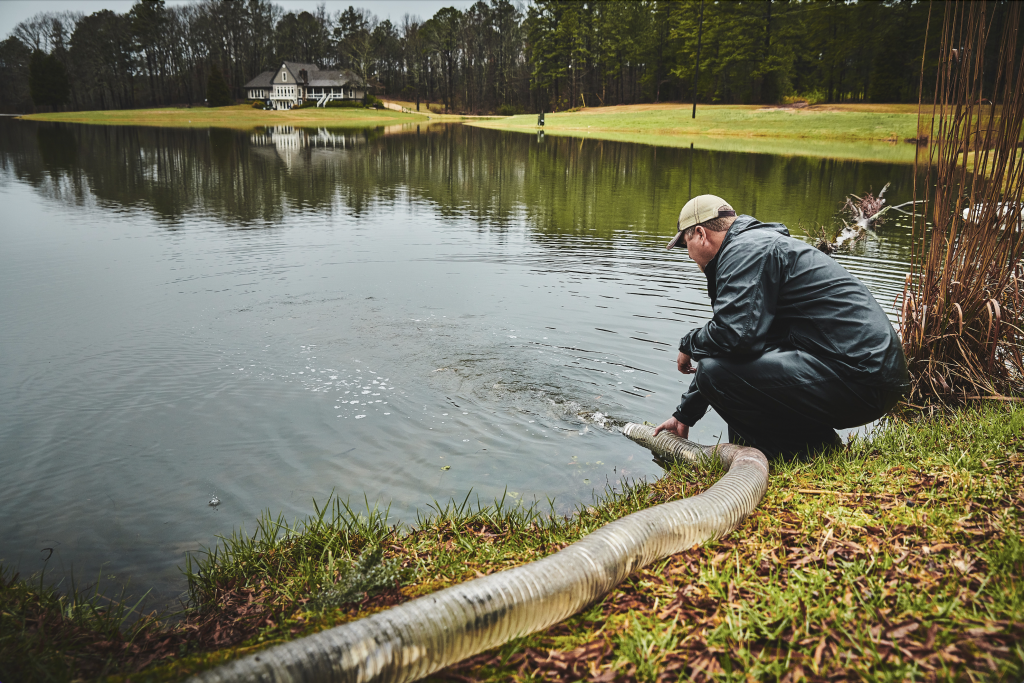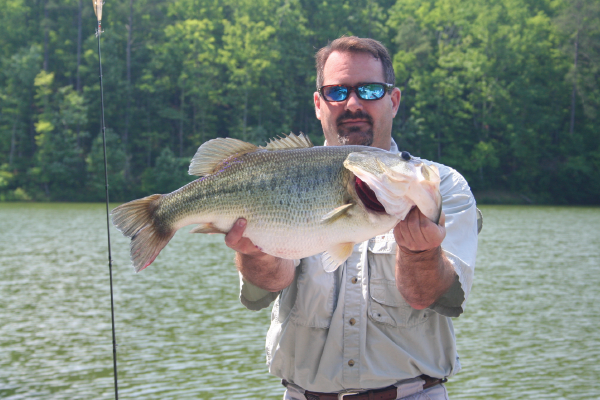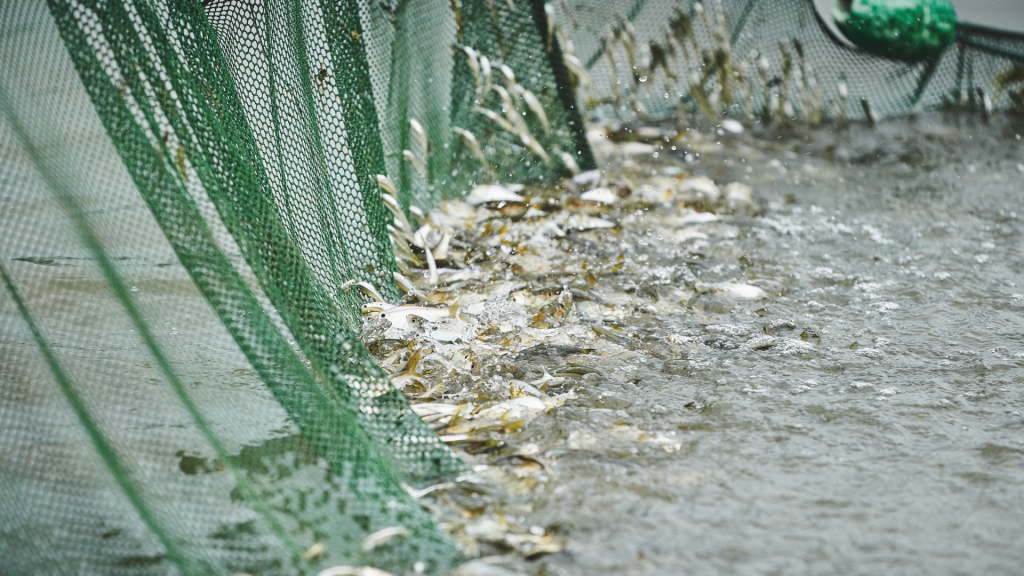If you live in the southeast and have a pond that you envision to be your “trophy fish factory” then it will only be a matter of time before you think about stocking some largemouth Tiger Bass that will aggressively and continuously hit lures and baits, are hardy enough to survive the occasional winter temperature dips and grow quickly, as much as one or even two pounds or more per year.
What is a Tiger Bass?
Tiger Bass is a hybrid freshwater fish that is a cross between a female Florida Bass (Micropterus floridanus) and a male Northern Bass (Micropterus salmoides). It was developed in private fish hatcheries as a sport fish and is known for its fast growth rate, aggressiveness, and large size. Tiger Bass have a unique and distinct appearance, with a tiger-like pattern on its scales, hence its name.
It has a deep, broad body, and a large mouth, making it an efficient predator of other fish, crustaceans, and insects. Tiger Bass were first introduced into the market in the late 1990s and has since become a popular game fish among anglers. It is stocked across the southern United States, where it has become a sought-after trophy fish due to its size and fighting ability.
Tiger Bass Growth Rate
Tiger Bass are known for their fast growth rate, and they can grow up to 16 inches in one year under ideal conditions. The growth rate of Tiger Bass can vary depending on factors such as water temperature, availability of food, and genetics. In general, Tiger Bass grow faster in warmer water temperatures between 75-85 degrees Fahrenheit. During the summer months, when the water is warmer, the growth rate of Tiger Bass can be accelerated.
The availability of food is also a crucial factor in the growth rate of Tiger Bass. Tiger Bass are a predatory fish and feed on a variety of prey, including fish, insects, and crustaceans. The more food available to a Tiger Bass, the faster it can grow. Genetics can also play a role in the growth rate of Tiger Bass. Fish hatcheries selectively breed Tiger Bass with the fastest growth rates, resulting in offspring that are genetically predisposed to grow faster than their wild counterparts. Overall, with proper management and optimal conditions, Tiger Bass has the potential to grow at an impressive rate, making it a popular sport fish for anglers.
Tiger Vs Largemouth Bass
Largemouth Bass are a native species of North America and are found in many freshwater lakes, rivers, and ponds. It is known for its large mouth and aggressive feeding behavior. Largemouth Bass can grow up to 29 inches in length and weigh up to 22 pounds. In terms of appearance, Tiger Bass have a tiger-like pattern on their scales, whereas Largemouth Bass has a greenish color with a dark stripe along its body.

While both species are popular among anglers, Tiger Bass is preferred by those who are looking for a more challenging and exciting fishing experience due to its aggressive behavior and fast growth rate. Largemouth Bass, on the other hand, is known for its size and is sought after by those who are looking to catch trophy-sized fish.
Northern (Native) Largemouth Bass
- Northerns are tough fish that can survive in a wide range of water temperatures from “ice over” to warm summer water.
- They have relatively fast growth rates that, depending on the pond’s forage fish base and if there are supplemental feeders utilized, can range up to two pounds a year. Even with relatively fast growth, the Northern strain bass rarely get over 10 pounds.
- They readily strike lures and baits and are naturally aggressive.
Florida Strain Bass
- Perfect for warm climates but not great for surviving colder weather conditions.
- They add weight quickly and consistently, even in older age and can get up to the 20-pound trophy level.
- When the water temperature drops, they become more lethargic and tend to lose aggressiveness in terms of biting lures and baits.
F1 Largemouth (Tiger Bass)
This is a hybrid mix between a Northern bass and a Florida bass and the result is the best of both strains.
- Can survive colder water better than Florida bass.
- Consistent growth rate over a longer period. F1s, like Florida bass, can grow upwards of 20 pounds and in well managed ponds can add two pounds a year. The U.S. record largemouth bass weighing 22 pounds 4 ounces was caught in Lake Montgomery, Georgia in 1932 is thought to be a cross between a Northern and Florida bass.

Brian Senn, host of the Great Days Outdoors weekly Alabama Freshwater Fishing Report. Senn has interviewed a number of sources regarding growing trophy bass in ponds and knows all about largemouth bass strains.
“They are aggressive feeders (not as aggressive as the Northern strain) and make for a good fishing quarry but they lose some of that aggressiveness as they mature and are a bit more reluctant to hit lures and become harder to catch. Consequently, you may need to restock them every four to six years to maintain the vigor of the Tiger population,” Senn said.
Are Tiger Bass the Solution to Your Problem?
Norman Latona is the founder and owner of Southeastern Pond Management, headquartered in Calera, Alabama with offices in two other states. Southeastern Pond Management offers full-service pond management services including fish stocking, fertilizing and weed control, electrofishing, pond design and construction and more.
“If you are catching a fish that has a bucket mouth, a five-pound head, and yet he weighs a pound and a half or catch a fish that weighs two pounds that isn’t plump and has a sucked-in belly, there probably is a balance issue,” Latona said. “That is what we refer to as bass or predator crowded and it is the most out-of-balance condition we run into,” he said. “The fish may be easy to catch, but it is frustrating and not that much fun when small bass is all that you catch.”
Latona points out that bass are like aquatic “saber-tooth tigers’ in that they are voracious feeders and if there are too many of them, they will eat themselves out of house and home. The result is a bass population of a bunch of “stunted” small fish. In a nutshell, to fix this problem you need to make a concerted effort to reduce the number of predator bass per acre, either by time and effort intensive “hook and line” methods (fishing) or the more efficient electrofishing, for which Southeastern Pond Management has the equipment and expertise to do. Once the predator population is at a manageable level then you can concentrate on the forage fish base.
“We utilize electrofishing and we can be very selective. It doesn’t hurt the fish. It just stuns them and we can pick and choose which fish we take out. So, in that respect, it’s probably even a better approach than hook and line and the process doesn’t damage any fish that we don’t want to remove,” Latona explained. “Electrofishing doesn’t really discriminate, it removes fish, not just the aggressive fish, not just the fish that don’t tend to be aggressive, we just select based on size. Obviously, we don’t take the seven to nine-pound fish, since these are the ones we are trying to produce.”
Tiger Bass Stocking Points to Consider
Both Latona and Senn pointed out that generally, the best time to stock F1 Tiger Bass is in the spring and early summer and, to avoid winter and high summer periods, which are greater fish stress times in order to keep mortality rates down.
The stocking issue is easier if you have a new pond than an existing one. In a new pond, there aren’t any predator fish present and it makes sense to stock your forage fish (bluegill and threadfin shad) first to allow them to get a solid base established before you introduce the bass predators. In an existing pond with a decent forage base, it is a good idea to remove as many of the “resident” predator bass as possible before you add the Tiger Bass… and the reason is size.

Senn said that in discussing this issue with a number of different sources, the typical size of a Tiger Bass brood fish is one to three inches which is the perfect size for dinner for resident predator bass. That defeats the whole purpose of introducing the new strain if they are going to be eaten before they can grow.
“The typical size of a Tiger Bass fish is one to three inches and the normal rate of stocking for that size fish is 50 to 100 per acre. Now if you haven’t reduced the predator bass presence in the pond it makes sense to stock Tiger Bass in the bigger six-to-eight-inch size so they won’t get gobbled up by the resident bass and more will survive.”
“I’ve found that, in general, the cost of a one-to-three-inch Tiger Bass is about $1.50, and for the six-to-eight-inch stock is about $6.00. So for a three-acre pond at 100 small fish per acre, it will cost you $450.00 but if you stock the larger fish at only 50 per acre the cost is twice that. It is a tradeoff depending on the situation. Southeastern Pond can help you determine the best route to take and advise you on the predator fish to forage fish ratio to get everything in balance and can help you fine-tune your pond depending on your goals.”
Do Tiger Bass Reproduce?
Tiger Bass, being a hybrid species, do not reproduce naturally. The crossbreeding of a female Florida Bass and a male Northern Bass is done through artificial propagation in fish hatcheries. The eggs of the female Florida Bass are fertilized with the milt of the male Northern Bass to produce the hybrid Tiger Bass offspring.
Since Tiger Bass is a sterile hybrid, it cannot reproduce naturally in the wild. This means that to maintain the population, they need to be produced in hatcheries and stocked into lakes, ponds, and rivers. However, some research has shown that in some cases, Tiger Bass may be able to reproduce with other bass species, producing hybrid offspring that have a different genetic makeup than the original hybrid.
Where Are F1 Tiger Bass for Sale?
F1 Tiger Bass are available for sale from Southeastern Pond Management and other private fish hatcheries that specialize in breeding and raising hybrid bass species. These fish hatcheries can be found in various locations throughout the southern United States, where Tiger Bass are most commonly stocked in lakes, ponds, and rivers for sport fishing. These hatcheries typically offer F1 Tiger Bass for sale in different sizes, ranging from fingerlings to adults.
If you are interested in F1 Tiger Bass stocking in your body of water, make sure you consult with a fisheries biologist to determine the appropriate strain of bass to stock and whether or not your lake or pond needs corrective action or amendments before you begin stocking. Done correctly, stocking bass can lead to years of enjoyment for you and your family. Done without proper planning, pond stocking may produce mixed results.




